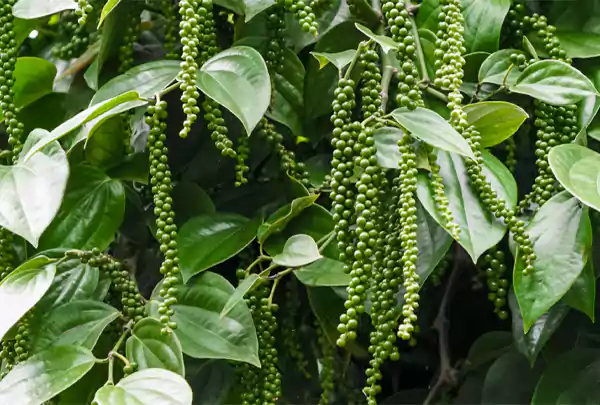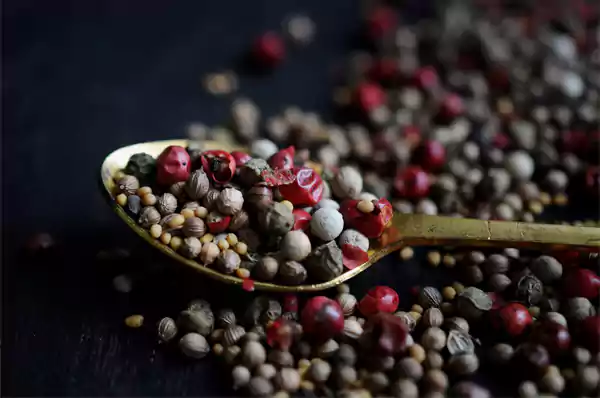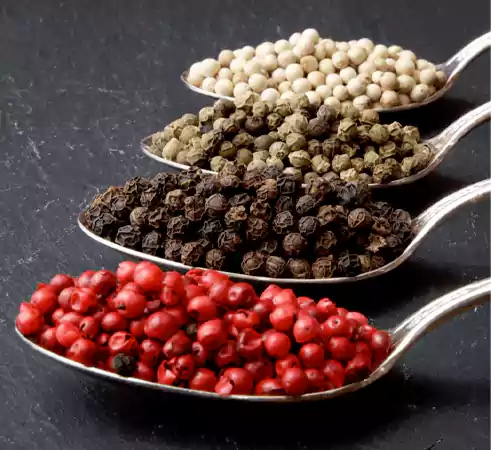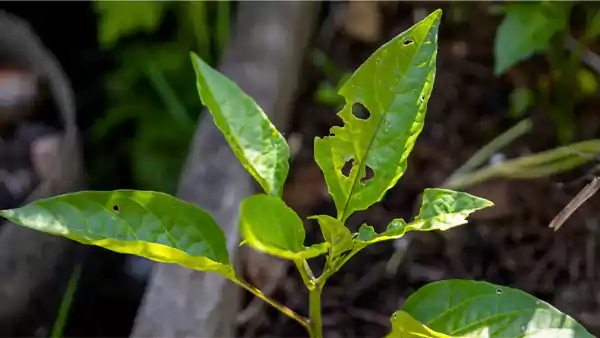
Whenever we want to add a quick flavor boost to our soups, pastas, or salads, we reach for pepper without hesitation! But have you ever wondered where it comes from, and how it is even harvested? The Peppercorn plant, scientifically known as Piper nigrum, is a tropical climber plant that produces the tiny berries, which we know as black, white, green, and even red pepper.
Native to India’s Malabar Coast, the Black Peppercorn [plant has been cultivated for thousands of years. Beyond its fame in the Indian kitchens, the genus can be a fascinating addition to any home or balcony garden, rewarding the plant lovers with flavorful spices at their fingertips. Whether you are drawn to its culinary magic, historical importance, or simply want to grow something unique, the peppercorn plant offers it all.
Moving further, jump into this immersive blog and discover how to grow, care for, and harvest your very own pepper vine! Keep reading to uncover intriguing facts about this spice powerhouse.
Did You Know?
The quest for pepper and other spices fueled historic voyages, including Vasco da Gama’s journey to India, which reshaped global trade routes.
Introduction: Historical and Cultural Importance of the Peppercorn Plant

As mentioned before, the Peppercorn plant is a climbing vine that produces tiny berries, which, when dried and processed, become black, white, green, or red pepper. This spice holds a permanent place in the kitchen across the globe.
The plant has glossy green leaves, skinny stems, and a cluster of small fruits that change color as they ripen. For thousands of years, pepper corn has been more than just a seasoning — it has been an essential commodity and shaped many trade routes during the ancient period.
Known as the “King of Spices”, it is prized for its ability to enhance the flavor of food and add a touch of luxury to meals. Apart from being a staple kitchen spice, it was often seen as a symbol of wealth and power back in those days. While the black pepper brings boldness to dishes, the white one adds a heat, and green pepper offers a fresh herbal flavor.
Whether it’s sprinkled over grilled vegetables, stirred into soups, or used to season meats, the Peppercorn seeds add a character to the food in a way no other spice can.
Botanical Background and Classification of the Peppercorn Seed
The peppercorn plant (Piper nigrum) belongs to the Piperaceae family. Understanding the scientific classification of the genus helps gardeners, botanists, and spice enthusiasts appreciate its uniqueness and its position in the plant family. Given below is the detailed botanical classification of the Peppercorn seed.
| Taxonomic Overview of the Peppercorn Plant | |
| Kingdom | Plantae |
| Clade | Tracheophytes |
| Clade | Angiosperms |
| Clade | Magnolids |
| Order | Piperales |
| Family | Piperaceae |
| Genus | Piper |
| Species | Piper nigrum |
| Common Name | Peppercorn Plant / Black Pepper |
By knowing the full classification of the genus, we know how it fits into the broader botanical context. The above overview also highlights its relation with other peppercorn cultivars and how each of them contributes as an agricultural crop.
Different Varieties of Pepper Corn

Although Peppercorns come in several varieties, all are harvested from the same plant. The difference lies in how and when they are processed, which creates their distinct flavors, colors, and uses. Let us explore some more varieties of this versatile global spice.
| Black Pepper: Harvested when the berries are still green. These are later boiled for some time and sun-dried until they turn wrinkled and black. With a strong and slightly citrus flavor, this cultivar is used as a universal seasoning. |
| White Pepper: Usually made from fully ripe red berries with the outer skin removed by soaking. It has a mild earthier flavor with a subtle heat. Used to make light colored sauces and creamy soups. |
| Green Pepper: Generally picked while unripe and preserved through the freeze-drying method. It has a fresh, herbal, and less pungent taste. Mostly used to make pickles, salads, stir fries, and light-flavored sauces. |
| Red Pepper: These are fully ripe berries, dried carefully to preserve their red hue. With a fruity, mildly sweet, and subtly hot taste, these are used for gourmet cooking and as a decorative garnish. |
Though they come from the same plant, all the different types of Peppercorn offer a remarkable range of flavors and colors. This allows the chefs and simple home cooks to add a special zest to their meals.
Ideal Growing Conditions Needed for the Pepper Corn Plant
Whether you cultivate the Peppercorn plant on a farm or grow it as a unique home garden species, understanding its preferred growing conditions helps in ensuring healthy outdoor or indoor vines offering long-term production.
| How to Grow Black Peppercorn | |
| Light Requirements | Grows best in partial shade or filtered sunlight. Naturally grows under tall trees when in the wild. |
| Soil Conditions | Prefers growing in well-draining loamy soil, rich in organic matter. The optimal pH level required is 5.5–6.5. Avoid heavy clay soils to prevent root rot. |
| Watering Needs | Keep soil consistently moist, but avoid waterlogging. Mulching can help in retaining the moisture and temperature of the soil. Needs high humidity to thrive. |
| Climate and Temperature | Prefers tropical or subtropical climates. The ideal temperature range is 24-29 degrees Celsius. Sensitive to frost, it cannot survive prolonged cold. |
Recreating its natural tropical environment and providing the plant with the right balance of warmth, moisture, and support ensures its healthy growth. Its stems can reach 3–4 meters in height if given proper support structure. Usually requires a trellis, pole, or living tree for climbing.
How to Grow a Peppercorn Plant?
Growing a Peppercorn plant can be a rewarding project for spice lovers and gardeners alike. With the right planting techniques, proper care, and patience, you can enjoy homegrown peppercorns straight from your garden or even a large container.
| Choosing the Right Propagation Method |
|
| Prepare the Planting Site or Pot |
|
| Planting Process |
|
| Initial Care |
|
| Patience and Maintenance |
|
With consistent care, proper support, and the right environment, your peppercorn plant will reward you with fresh, aromatic pepper for years.
The joy of harvesting your own spice makes the wait and effort entirely worthwhile for any passionate grower. Now that you know how does black peppercorn grow, let us discover some fascinating facts about the genus.
Fun Facts About the Peppercorn Plant
Did you really think the black peppercorn is just a kitchen staple? The genus has a rich history, and there are definitely some interesting facts about the plant. These fun facts reveal why Piper nigrum has been valued for centuries and remains the “King of Spices” today.
- Pepper was once used as currency. In ancient Rome and Medieval Europe, pepper was so valuable that it was traded like gold and used to pay taxes, dowries, and even ransom fees.
- Black, white, green, and red peppercorns all come from Piper nigrum; the difference is in when they are harvested and how they are processed.
- With proper care, a single peppercorn vine produces berries for 20+ years, making it both a culinary and agricultural investment.
- Traditionally, pepper has been used in Ayurvedic and Chinese medicine for digestion, colds, and boosting nutrient absorption.
From its role as ancient currency to its enduring place in the Indian kitchen, this genus is more fascinating than it appears.
Common Pests and Diseases That Affect the Growth of the Plant

Just like any other plant, the Peppercorn vines also face challenges from pests and diseases that can impact the growth and yield. Let us understand some common issues and how to treat them to ensure a healthy, productive pepper harvest for your kitchen or garden.
| Common Pests | Common Diseases |
| Mealybugs: Small, white, cotton-like insects that stick on the back of leaves and eventually turn them yellow. | Root Rot: Caused by overwatering and fungal pathogens, which eventually lead to root decay. |
| Aphids: Tiny black bugs that mainly affect the new shoots, spreading diseases and weakening the plant. | Anthracnose: Fungal infection causing dark, sunken spots on leaves, reducing the quality of the plant. |
| Scale Insects: These are hard-bodied insects that attach themselves to the stems of the genus, leading to leaf drop. | Wilt Disease: Another infection that blocks water flow, causing extreme wilting. If untreated, the plant can eventually die. |
| Leaf Beetles: Create small holes in the leaves, reducing photosynthesis and plant health. |
Be sure to use well-draining soil to avoid root rot. Regularly inspect plants for pests and remove infestations early. Use organic insecticidal soaps to control these issues. By staying alert and using natural pest control methods, you can keep your plant healthy and productive.
Conclusion and Key Takeaways
Growing a Peppercorn Plant is a fulfilling journey that connects you with one of the world’s most beloved spices. Understanding its botanical background, varieties, and ideal growing conditions helps you provide the care needed for a fruitful harvest. Whether you want to grow black, white, green, or red peppercorns, the difference lies mainly in the harvest time and processing, which makes this genus extremely versatile.
From being a treasured spice in the ancient period to being a main seasoning for your meals today, this plant remains a valuable addition to any garden or home. So, without any further ado, go ahead and grow this stunning spice plant because nothing beats seasoning your food with homegrown spices!
Can you grow Peppercorns in the US?
Yes, you can grow peppercorn plants in the US, but only in warm, humid regions or indoors with controlled temperatures.
Is Peppercorn the same as Black Pepper?
Yes, Black Pepper is actually made from the dried unripe berries of the Peppercorn plant.
What are the health benefits of Pepper?
Pepper aids digestion, boosts metabolism, and has antioxidant and anti-inflammatory properties used in traditional medicine.
Are Peppercorn plants perennial?
Yes, peppercorn plants are perennial vines that can live and produce fruit for many years, often over 20 years, with proper care.
Do peppercorn plants need full sun?
No, they prefer partial shade or filtered sunlight and usually grow under tall trees in the jungle.
Black Pepper — Britannica
